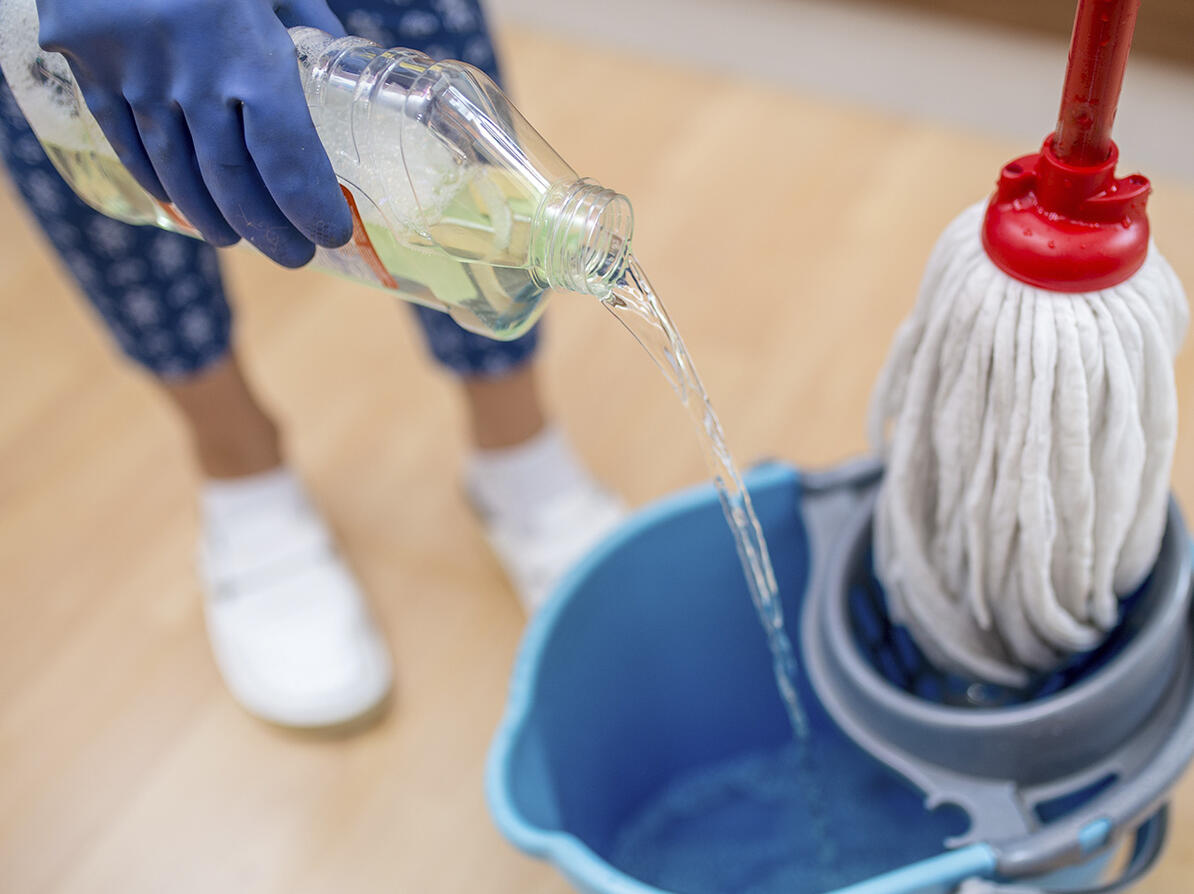Test: These chemicals are used in floor cleaners
Floor cleaners can contain unwanted chemicals that can cause allergies. The test guides you to the choice of floor cleaners without unwanted chemicals.

Test: Are there unwanted chemicals in your floor cleaner?
In the test of floor cleaners, the Danish Consumer Council THINK Chemicals has checked 30 products that are intended for washing different types of wooden floors and other natural materials.
The range of floor cleaners in the test ranges widely, including more specialized floor cleaning and care products intended for oil-treated wooden floors.
Brown soap, soap shavings and other more general products are also included in the test. In addition to floor cleaning, they can also be used for many other types of cleaning.
Floor cleaning: Several good choices among floor cleaners in the test
The tested products are in several cases both free of perfume that can cause allergies and a number of other problematic chemicals.
You can find the good chemical choices among both the brown soaps and soap shavings. You can also find products that get the best rating (A), among the actual floor cleaners.
Unwanted chemicals: Be aware of these substances
Typically, your hands are in contact with the floor cleaner when you wash the floor.
Therefore, choose a product without unwanted chemicals. In floor cleaners, you can look for the following substances, all of which are preservatives:
- Benzisothiazolinone and octylisothiazolinone, which are related to the more well-known and allergenic substance methylisothiazolinone (MI)
- 2-bromo-2-nitropropane-1,3-diol (bronopol) preserving by cleaving allergenic formaldehyde
- Zinc pyrithione, classified in the EU to impair fertility.
You can always look at the product to see which preservatives are used.
Actually, preservatives must always be indicated on the packaging.
Which products are good for cleaning and caring for which types of floors?
In the test, the floor cleaners were only examined for problematic substances in the declared content.
The floor cleaners have not been tested for how well they wash and care for different types of floors.
Follow the manufacturer's instructions on the intention of the product. Not all products are intended for all types of floors.
About the test
-
The Danish Consumer Council THINK Chemicals has bought 30 different floor cleaners in various Danish shops and webshops.
The range covers special floor cleaners, which are used for oil-treated wooden floors. There is also brown soap and soap shavings, which in addition to being suitable for floor washing of certain types of wooden floors also can be used for much else.
The test is a declaration test
The Danish Consumer Council THINK Chemicals has carried out a so-called declaration test of the chemicals in the floor cleaners.
The test is based on what content is declared on the product or on the associated website. In many cases, it was neither possible to view content on the product nor find the required ingredient list online. In those cases, the test team has received the ingredients from manufacturers and retailers.
No chemical analysis of the contents has been performed. The test therefore does not take into account the concentration of the chemical substances in the individual product.
The individual product in the test does not necessarily pose a risk in itself, even if it contains problematic substances.
However, the product can contribute to an overall exposure to, for example, endocrine disruptors or allergens. Following the "Little strokes fell great oaks" principle, it is therefore a good idea to avoid problematic substances where you can.
-
A total of 30 floor cleaners are included in the test.
- 11 products are without a number of problematic substances and get A rating.
- 14 products contain perfumes or substances that can be problematic for the environment and get B rating.
- 5 products contain problematic chemicals, including allergenic preservatives, and get C rating.
We have found these problematic substances
In the test, the following substances trigger the lowest rating, C:
- Benzisothiazolinone, which can cause allergies, is found in 4 products.
- Octylisothiazolinone, which can cause allergies, is found in 2 products.
- 2-bromo-2-nitropropane-1,3-diol that can cause allergies is found in 2 products.
- Zinc pyrithione, which is suspected of impairing fertility, has been found in 1 product.
- Hexamethylindanopyran, which is suspected to be an endocrine disruptor, has been found in 1 product.
These ingredients trigger the average rating B
- Perfume and perfume substances that can cause allergies have been found in 12 products.
- EDTA compounds that are problematic for the environment have been found in 2 products.
Read more about the substances below.
Allergenic preservation
Benzisothiazolinone, octylisothiazolinone and 2-bromo-2-nitropropane-1,3-diol, also called bronopol, are all allergenic preservatives.
Are these used in a detergent, it must be stated on the product packaging.
Benzisothiazolinone and octylisothiazolinone belong to the group of isothiazolinones which also include methylisothiazolinone (MI) which is the best known.
MI is the only one of the 3 substances that may also be used in certain personal care products. Benzisothiazolinone and octylisothiazolinone, on the other hand, are not allowed in personal care products, but are permitted in cleaning products such as floor detergent.
The isothiazolinones can cause allergies on skin contact, but they can also trigger allergies via the air. If you have an allergic reaction to one of the substances, there is also a risk that you will react to the other isothiazolinones.
2-Bromo-2-nitropropane-1,3-diol, also called bronopol, is one of the preservatives that have a preservative-releasing effect on small amounts of formaldehyde. Formaldehyde is allergenic, which therefore also applies to bronopol.
Suspected of damaging fertility
Zinc pyrithione is suspected of harming the unborn baby.
In 2020 the substance has therefore been classified in the EU as suspected of being able to damage fertility.
It is still permitted to use the substance in detergents, where it is added as a preservative.
Suspected of being endocrine disrupting
Some substances are suspected to be able to affect the hormone balance in the body.
Hexamethylindanopyran, which is suspected of being an endocrine disruptor, has been used in one of the floor cleaners.
The substance is legal to use and the individual product does not pose a risk. However, if you want to reduce your total exposure to the problematic substances, you can advantageously choose products without content of suspected endocrine disruptors.
Perfume that can cause allergies
Perfume can cause allergies. The more you expose your skin to perfumes, the greater the risk of developing allergies in the long term.
It can therefore be a good idea to limit how much perfume you expose your skin to, among other things by choosing cleansers without perfume.
Perfume has no effect on how well the detergent works - only on how it smells during and after cleaning.
Cleaning products with the allergy label 'The Blue Label' are completely free of perfume.
Environmentally problematic substances
Some of the substances in floor cleaners can be problematic for the environment.
These are, for example, the so-called EDTA compounds, the perfume substance limonene, zinc pyrithione and octylisothiazolinone.
The EU have for example classified these substances as harmful to the environment.
Ingredients can be hard to find
Manufacturers of floor detergent are not required to include a full list of ingredients on the packaging. Although this applies for example for cosmetic products and foods that must have a full declaration.
Instead, it should be possible to find a list of the ingredients of the cleaning products, also called a data sheet, on a website. This website must be marked on the product.
In general, ingredient lists of detergents are far too difficult to find if at all available online.
This also applies to the investigated floor cleaners, where all too often the full list of ingredients were not available online.
The legislation that should ensure access to knowledge about ingredients in cleaning products is therefore not working as intended.
The Danish Consumer Council THINK Chemicals encourages companies to make it easy for the consumer to find information about ingredients on the website.
The Danish Consumer Council THINK Chemicals also recommends that a full declaration of the product itself becomes a requirement for detergents.
Do you want to know what your detergent contain?
Look for detergents with the allergy label ‘The Blue Label' if you want to know what is in your detergent.
The label requires that all ingredients appear on the label.
If you have an allergy-labeled product, you thus have a full list of ingredients at hand.
Perfume and preservation must be stated on the product
The contents of certain selected substances must be on the packaging of all cleaning products.
Perfume and declarable perfume substances such as limonene and linalool must always be stated on the label if they are included in the product.
The same applies to preservatives, if any. They must always be indicated by their chemical name.
You must be able to find the rest of the ingredients online
Information about other ingredients in your cleaning product must be available online via the link that according to law must be stated on the product.
However, it can be very difficult to find this information.
In those cases, you must ask the manufacturer to send you a link to the data sheet with the ingredients.
-
Comment from Moland:
"A little bit of preservation is needed in most water-based products, as otherwise they risk rotting after a relatively short time. However, we use so little preservation in the product that it is not classified as allergenic or dangerous to the environment. The preservatives therefore appear only on the list of ingredients, because all ingredients in the product must be stated, regardless of quantity. We fear the product is described more dangerous than it actually is."
Comment from Esbjerg Farve- & Lakfabrik A / S, which is responsible for Faxe:
"A little bit of preservation is needed in most water-based products, as otherwise they risk rotting after a relatively short time. However, we use so little preservation in the product that it should not be classified as either allergenic or dangerous to the environment. "To put this in perspective, our Faxe Oil Care, if it were a paint, would meet the criteria for becoming the Nordic Ecolabel and the Indoor Climate Label. We fear the product is described more dangerous than it actually is."
Comment from Bona AB:
The manufacturer states that the content of benzisothiazolinone in the product is low and below the amount in which the product is to be classified.
Comment from Borup:
"Overall, Borup has a strategy to avoid substances that are, or are suspected of being endocrine disruptors, just as we try as far as possible to use as environmentally friendly raw materials as possible in our products. It is an ongoing process in our quality department to review our range of "problematic" raw materials and make sure to have them replaced when and if we come across any. Although we have come a long way in recent years, we have not yet reached the end goal. We still lack a smaller portfolio of products from various subcontractors, including our Laundry & Floor Care Luxury, which we need to examine quite soon. We expect to have finished our program by the summer of 2021. "
